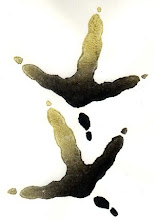The topic appears to be a surprisingly difficult thing to research on the web, but I did turn up some good info about the introduction of guns in Japan at the following site:
http://www.rekihaku.ac.jp/e-rekihaku/126/rekishi.html
If you take a look at that site you'll see different shot size recommendation for ducks:
I've also done a bit of digging around for historical references to recreational hunting among the samurai class, and found the following costume info at the Costume Museum in Kyoto, Japan.
A look at the picture of the birds in this book reveals a "kuishime" shot at the point where there is a mandarin duck and a "oikuri" (chaser) shot where there are two ducks. The "kuishime" shot was cut off slightly at both ends forming a cross with two lines of equal length, adjusted with a screw, and plastered with torinoko paper. The "oikuri" shot contained a ground charge of 1.5 monme (5.63 g), a shitatama (bottom shot) of 0.2 monme (0.75 g), then 1.5 monme (5.63 g) of gunpowder in between, and 0.2 monme (0.75 g) otori of lead shot. In this way, various types of shot were made to correspond to the prey for which they were intended.
Information given at the beginning of the Uda School Book of Secrets stresses that these are methods for shooting birds and animals. The features of the birds and animals in these pictures are well drawn and descriptions of their habitat are also accurate. This can be nothing else besides an authentic treatise on the art of hunting.
|
2 igote
3 suikan-no-kami
4suikan-no-shimo
5 utsubo
6 kawazutsumi-no-tachi
7 tsurumaki
8 monoi-gutsu
9 ayai-gasa
10 mukabaki
11 koshi-gatana
12 yumi
13 yukake
Explanation:Jim again: apparently hunting grew to be popular among the samurai during the Kamakura Period (1185 - 1392), when the leadership of Japan passed from the nobility to the samurai warrior class. I will see if I can dig up some decent samurai hunting haiku . . . .
A samurai wore this costume called " kari - shozoku" when hunting in the fields [or in case of "yabusame," a kind of samurai's a game].The samurai wore "nae-eboshi" cap and "ayai-gasa" hat knitted with rush from the top.
The center of the hat is referred to as "koji" and it is high in order to put in "motodori" collected hair.
For the bottom, the samurai wore "suikan" or "hitatare."
Moreover, the samurai wore "igote" protector to the left arm and "yugake," leather gloves called "tebukuro" in case of "yabusame."
"Yugake (=scald)" is glove made of leather attached for protection of a finger when shooting a bow.
The samurai also wears a cover of deer's summer skin called "mukabaki."
He wore a pair of "monoi-gutsu" shoes on foot and hung a long sword on the waist.
The figure in the photo hangs "utsubo," a arrow holder, [a "ebira" holder in case of "yabusame"], and has a bow and a waist sword.
"Utsubo (=quiver)" is the container of the shape of a pipe for carrying arrows.













2 comments:
I hope Cabin Boy
Mister Zen of Mossy Oak
pays close attention
I am telling you, there at least two new camo patterns and at least 1 Versace show in that get up. Fabulous. I think you found your research niche dr. T.
Post a Comment